
Axolotl (Ambystoma mexicanum): an aquatic salamander.
Kingdom: | Animalia
Phylum: | Chordata
Class: | Amphibia
Order: | Urodela
Family: | Ambystomatidae
Genus: | Ambystoma
Species: | A. mexicanum

Size and Weight:
Axolotls measure 6 to 18 inches in length and weigh 2 to 8 ounces.
Appearance:
The axolotl is a type of salamander. It has a long tail, flat head, and four lizard-like limbs, which it uses to move around the lake floor. But unlike other salamanders, axolotls are neotenic, meaning they keep juvenile characteristics into adulthood. The axolotl remains aquatic, like larvae, their entire life. While it develops functional lungs, it uses its feathery gills to breathe underwater. Like youngsters, they retain external gills, a tail, and a body fin, and lack moveable eyelids.
Axolotls range in color depending on the individual. They are most often dark-colored, ranging from black, brown or gray, accompanied by small spots all over their bodies. While they are often dark-colored, they can shift their hue a few shades lighter or darker as needed for camouflage. Pink and light-colored axolotls are often bred by humans as pets.
One of the most astonishing characteristics of the axolotl is its ability to regenerate almost any lost body part faster than any other species. It can regenerate its limbs, lungs, heart, jaws, spines, and even parts of its brain! For this reason, axolotls are used in research to apply this ability to human nerve cells and organs.

Diet:
Despite their undeveloped teeth, axolotls are effective predators. They feed on worms, mollusks, crustaceans, insect larvae and small fish. During the day, they burrow into the aquatic vegetation and mud to avoid predators. At night, they hunt for food using a suction technique. While suctioning up food, gravel may also get inhaled, which helps grind up food in its belly.
Habitat:
The axolotl is lentic, meaning it inhabits still-water lakes.
Geography:
Axolotl can be found in only two freshwater lakes: Mexico’s Lake Xochimilco and Lake Chalco. These lakes are Mexico City’s primary water source.

Breeding:
Axolotls reach sexual maturity at six months of age. The breeding season occurs between March and June. Prior to mating, a waltz occurs between a male and female. They rub and slide against each other while twirling in a circular fashion. After about 30 seconds of this display, the male drops a cone of his sperm, which the female collects with her cloaca. The fertilization of her 300 to 1,000 eggs begins. She lays her eggs individually, placed on plants or rocks to avoid predators. The eggs hatch about two weeks later and the young swim off. The young are on their own, as there is no parental care.
Social Structure:
This amphibian’s behavior can range from social to solitary and active to dormant.

Lifespan:
The axolotl lifespan is 10 to 15 years.
Threats:
Pollution, habitat degradation, urbanization, and water diversion from an ever-growing human population are the largest threats to the axolotl. It has few natural predators but may be fed on by storks, herons or large fish on occasion. Other threats include predation from introduced fish and large birds, as well as over-collecting them for food and medicine.

Conservation Status:
The axolotl is listed as Critically Endangered by the IUCN’s Red List of Threatened Species.
Conservation Efforts:
Conservationists are working to save the axolotl by building shelters in Xochimilico, with stacks of rocks and reedy plants to help filter clean water that is pumped in. These shelters are created with the hope that the species will breed and thrive.
Sources: San Diego Zoo Wildlife Alliance and Detroit Zoo.
